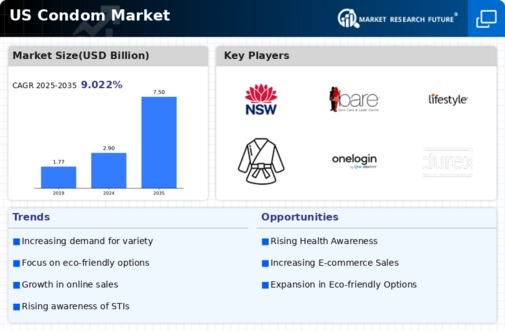Evolving Consumer Preferences
Consumer preferences are evolving, significantly impacting the condom market. There is a noticeable shift towards premium products that offer enhanced features, such as added lubrication or unique textures. This trend is driven by a younger demographic that seeks both quality and variety in their sexual health products. In the US, market data suggests that sales of premium condoms have increased by around 30% in recent years, indicating a willingness among consumers to invest in higher-quality options. Furthermore, the rise of subscription services for condom delivery has also changed purchasing behaviors, making it more convenient for consumers to access a range of products. This evolution in preferences is likely to continue shaping the landscape of the condom market.
Growing Awareness of Sexual Health
The increasing awareness of sexual health and safe practices is a pivotal driver in the condom market. Educational campaigns and public health initiatives have significantly contributed to a heightened understanding of sexually transmitted infections (STIs) and unintended pregnancies. As a result, consumers are more inclined to purchase condoms as a preventive measure. In the US, studies indicate that approximately 45% of sexually active individuals use condoms regularly, reflecting a growing trend towards responsible sexual behavior. This awareness is further bolstered by the availability of diverse condom options, catering to various preferences and needs. Consequently, the condom market is likely to experience sustained growth as more individuals prioritize their sexual health and well-being.
Regulatory Support and Health Initiatives
Regulatory support and health initiatives are vital drivers of the condom market. Government programs aimed at reducing STIs and unintended pregnancies often include the distribution of free or subsidized condoms. In the US, various public health organizations actively promote condom use as a key strategy in sexual health education. This support not only increases accessibility but also encourages individuals to incorporate condoms into their sexual practices. Recent data indicates that areas with robust public health initiatives have seen a 15% increase in condom usage among young adults. Such regulatory efforts are likely to continue fostering a favorable environment for the condom market, ensuring sustained growth and consumer engagement.
Impact of Social Media and Influencer Marketing
The influence of social media and digital marketing strategies is becoming increasingly prominent in the condom market. Brands are leveraging platforms like Instagram and TikTok to engage with younger audiences, promoting safe sex practices in a relatable manner. Influencer partnerships have proven effective in normalizing discussions around sexual health and encouraging condom usage. In the US, social media campaigns have led to a measurable increase in brand awareness, with some companies reporting a 25% rise in sales following targeted influencer promotions. This shift towards digital engagement not only enhances brand visibility but also fosters a community that prioritizes sexual health, thereby driving growth in the condom market.
Technological Advancements in Product Development
Technological innovations play a crucial role in shaping the condom market. Manufacturers are increasingly investing in research and development to create products that enhance user experience and safety. For instance, the introduction of ultra-thin condoms has gained popularity, as they provide a more natural feel while maintaining effectiveness. Additionally, advancements in materials, such as the use of polyisoprene and polyurethane, offer alternatives for individuals with latex allergies. The US market has seen a rise in the adoption of these innovative products, with sales of non-latex condoms increasing by approximately 20% over the past few years. Such developments not only cater to consumer preferences but also contribute to the overall growth of the condom market.



















Leave a Comment